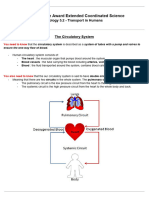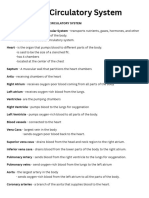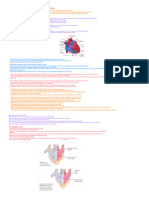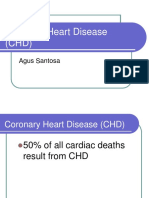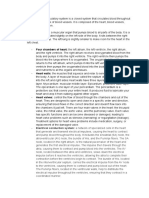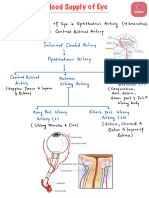Biology AS Revision: Single Circulatory System
Biology AS Revision: Single Circulatory System
Uploaded by
Kieran ArronCopyright:
Available Formats
Biology AS Revision: Single Circulatory System
Biology AS Revision: Single Circulatory System
Uploaded by
Kieran ArronOriginal Title
Copyright
Available Formats
Share this document
Did you find this document useful?
Is this content inappropriate?
Copyright:
Available Formats
Biology AS Revision: Single Circulatory System
Biology AS Revision: Single Circulatory System
Uploaded by
Kieran ArronCopyright:
Available Formats
Biology AS revision
Single Circulatory System - Found in fish - Two chambered heart instead of 4 - Blood travels to gills, passes through capillaries, where it picks up Oxygen and loses some pressure. - Then goes back to the heart but at a lower speed due to lower pressure Double Circulatory System - Found in Mammals and Birds - A Pulmonary and a Systemic Circulation - Pulmonary goes from heart to lungs - Systemic goes from heart to the rest of the body - Must have 4 chambers (2 Atri & 2 Ventricles) - Right side of the heart receives deoxygenated blood and pumps it to lungs - Left side receives the oxygenated blood and gives it a boost so that it can travel around body
Heart Structure - Cardiac Muscle - Right Atrium - Left Atrium - Right Ventricle - Left Ventricle (this has the thickest muscle as it is responsible for pushing blood around entire body) - Deoxygenated blood enters the right atrium via the superior vena cava and inferior vena cava, it then enters the right ventricle through the right tricuspid valve and then it is pushed into the lungs via the pulmonary arteries (the only arteries carrying deoxygenated blood) Oxygenated blood then passes back Into the heart via the pulmonary veins into the left atrium
which then enters the left ventricle via the left bicuspid valve where it then receives a boost to go around the entire body Valves Atrio-Ventricular Valves (AV Valves) - These are the Tricuspid and Bicuspid valves - As the name suggests they are between the atrium and ventricle. The tricuspid valve has three cusps/flaps whilst the Bicuspid valve has two cusps/flaps Semi-Lunar Valves - Guard the openings to pulmonary artery and aorta and prevent backflow, both valves have three semi-lunar cusps How The Heart Beats Sequence of events in a heartbeat are known as the cardiac cycle This cycle has four overlapping processes - Atrial Systole: Both Atria contract, forcing blood into the Ventricles - Ventricular Systole: Both ventricles contract, forcing blood through the pulmonary artery to the lungs and through the aorta to the rest of the body - Atrial Diastole: The Atria relax, Ventricles are still contracted. Blood enters the Atria from the large veins coming from the body - Ventricular Diastole: Ventricles relax and become ready to fill with blood from the atria as the next cycle begins
Control Of The Cardiac Cycle - Heartbeat must be carefully controlled so that the chambers only beat when they are full of blood. This is done by coordinating the cardiac cycle - Each heartbeat starts with an impulse from the SA Node (Sino-Atrial Node which is located on the right atrium. This is known as the pacemaker. The electrical signal spreads over the atrium causing it to contract. - The signal does not directly pass to the ventricles, if that happened then they would contract before they were full of blood (this isnt very good) so the signal is delayed slightly by the Atrio-Ventricular Node (AV Node) where it picks up the signal and passes it through a collection of muscle fibres in the ventricular septum known as the Bundle Of His, from here the signal spreads through the wall of the ventricles, through the Purkyne fibres and the ventricles contract Blood Vessels - Three major types: Arteries, Veins & Capillaries - Arteries carry blood from the heart - Arteries branch into smaller Arterioles - Arterioles then branch into Capillaries - Capillaries are permeable and are only 1 cell layer thick this allows exchange between blood and nearby cells, blood flows from capillaries into venules, which drain into larger veins. - Both Arteries and Veins have the same three layers: Tunica Externa, Tunica Media & Tunica Interna. The thickness abd composition of these layers differ depending on the function of the vessel. - Arteries have a particularly thick Tunica Media containing smooth muscle and elastic fibres - Veins have a thinner Tunica Media and a larger lumen to carry slower-flowing blood at low pressure. Capillary Circulation The circulatory system keeps all cells bathed in tissue fluid. The
tissue fluid has a reasonably constant composition because capillaries allow exchange of materials between blood and fluid. How tissue fluid is formed - Blood from the arterioles is under high hydrostatic pressure (physical pressure from the contraction of the ventricles) When blood enters a capillary, substances are forced out through the permeable wall. The capillary walls act as filters and a proportion of all chemicals under a particular size is squeezed, forming tissue fluid. The composition of Tissue fluid is very similar to blood plasma. Structure and Function In Blood Vessels Vessel Artery Structure Rich in elastic fibres; very tough elastic walls with some muscle fibres Function Recoil; withstands surges in pressure and maintains diastolic blood pressure Higher proportion of Can constrict or muscle to elastic dilate to control fibres compared to blood supply to artery particular areas Thin, permeable Allows rapid diffusion and exchange Relatively thin; Returns blood to contain valves; heart under low have larger lumen pressure, valves than similar sized prevent backflow artery
Arteriole
Capillary Vein
You might also like
- Cardiac Surgeries: and ManagementDocument64 pagesCardiac Surgeries: and ManagementSimon Josan50% (2)
- Circulatory System Notes IgcseDocument19 pagesCirculatory System Notes IgcseWork WiseNo ratings yet
- Module 3 The Circulatory SystemDocument11 pagesModule 3 The Circulatory SystemAndriya JoshyNo ratings yet
- Chapter 08Document9 pagesChapter 08Richa KhareNo ratings yet
- Cardiovascular SystemDocument6 pagesCardiovascular Systemapi-297526590No ratings yet
- 3 Circulation in ManDocument7 pages3 Circulation in ManAnasatcia Mcpherson 9c FNo ratings yet
- Cardiovascular SystemDocument34 pagesCardiovascular Systemurooj100% (2)
- Transport in Man NotesDocument9 pagesTransport in Man NotesYeo JhNo ratings yet
- Cardivascular System NyamweyaDocument50 pagesCardivascular System Nyamweyalinetmuthoniw4No ratings yet
- The Circulatory SystemDocument4 pagesThe Circulatory SystemJoiSatannNo ratings yet
- Cardiac SystemDocument18 pagesCardiac Systemviduship322No ratings yet
- Cardiovascular System: Presented by DR Aparna Ramachandran Mds 1 Dept of Public Health DentistryDocument73 pagesCardiovascular System: Presented by DR Aparna Ramachandran Mds 1 Dept of Public Health DentistryAparna RamachandranNo ratings yet
- CARDIOVASCULAR SYSTEMDocument11 pagesCARDIOVASCULAR SYSTEMAbhishek Yadav GkpNo ratings yet
- bio circulatory systemDocument17 pagesbio circulatory systemcesiamaradiaga25No ratings yet
- Parts and Function of Heart: Group 5 9 - ActsDocument47 pagesParts and Function of Heart: Group 5 9 - ActsJasmin GarciaNo ratings yet
- The Circulatory SystemDocument25 pagesThe Circulatory SystemRahil BhavanNo ratings yet
- Assignment On Anatomy and Physiology of Heart: Submitted By: Submitted To: Jayita Gayen Madam S. PoddarDocument10 pagesAssignment On Anatomy and Physiology of Heart: Submitted By: Submitted To: Jayita Gayen Madam S. PoddarJayita Gayen DuttaNo ratings yet
- W.G. Igcse Transport in HumansDocument20 pagesW.G. Igcse Transport in Humansbloodshooter1996No ratings yet
- The Blood System Presentation Power PointDocument24 pagesThe Blood System Presentation Power Pointrlmari0314No ratings yet
- Cardio Vascular SystemDocument8 pagesCardio Vascular SystemguptaasitNo ratings yet
- Ch 11 Cardiovascular System 160217162530 (1)Document94 pagesCh 11 Cardiovascular System 160217162530 (1)raidoyel06No ratings yet
- Human Circulatory System: Erika Grolmusová 2.A/2Document22 pagesHuman Circulatory System: Erika Grolmusová 2.A/2Barbora PiatkováNo ratings yet
- Cardiovascular and Syrculation System, 2013Document92 pagesCardiovascular and Syrculation System, 2013Santi Purnama SariNo ratings yet
- Cardiovascular System BSN 1Document16 pagesCardiovascular System BSN 1Arianne Jen GenotivaNo ratings yet
- Transports Nutrients and Water Transports Gases Like Oxygen Transports Hormones Heals and Fight InfectionsDocument46 pagesTransports Nutrients and Water Transports Gases Like Oxygen Transports Hormones Heals and Fight InfectionsElla LlamasNo ratings yet
- Blood Circulation and TransportDocument23 pagesBlood Circulation and TransportcikzafirahNo ratings yet
- Cardio Vas UlarDocument33 pagesCardio Vas UlargujalesiddharthNo ratings yet
- Circulatory System NursingDocument72 pagesCirculatory System NursingTamiru TekileNo ratings yet
- Chapter 14.1 - Cardiovascular System - Blood VesselsDocument56 pagesChapter 14.1 - Cardiovascular System - Blood VesselsMichael PeraltaNo ratings yet
- Circulatory System PlanDocument95 pagesCirculatory System Plankirsten23No ratings yet
- Minggu 13 Peredaran DarahDocument11 pagesMinggu 13 Peredaran Darahcuksam27No ratings yet
- Notes Chap9Document7 pagesNotes Chap9yuaf8810No ratings yet
- HeartDocument9 pagesHeart..........No ratings yet
- The Circulatory System P2Document17 pagesThe Circulatory System P2Kristal CampbellNo ratings yet
- The Cardiovascilar System Medical TerminologyDocument8 pagesThe Cardiovascilar System Medical TerminologyJeya Plays YTNo ratings yet
- CardioDocument29 pagesCardioDr santoshNo ratings yet
- احلام 1 PDFDocument7 pagesاحلام 1 PDFEhab Alaa Abd Al-AmeerNo ratings yet
- Heart Physiological Anatomy Pt.1&2Document34 pagesHeart Physiological Anatomy Pt.1&2abdu42775No ratings yet
- Science-9-Circulatory-System-1Document2 pagesScience-9-Circulatory-System-1yabutfernando422No ratings yet
- Circulation NotesDocument7 pagesCirculation NoteshitchbichykujoNo ratings yet
- Cardiovascular SystemDocument86 pagesCardiovascular SystemkishabiotechNo ratings yet
- Heart Page - (1677340777450)Document1 pageHeart Page - (1677340777450)ainalashari69No ratings yet
- TheHumanCirculatorySystem (Renu)Document20 pagesTheHumanCirculatorySystem (Renu)onlinebaijnathNo ratings yet
- Cardiovascular NotesDocument16 pagesCardiovascular NotesPRAGATI RAINo ratings yet
- B7: Transport in Mammals: The Right DirectionDocument5 pagesB7: Transport in Mammals: The Right DirectionJoelle SwaisNo ratings yet
- The Circulatory System: Agriscience 332 Animal Science #8646-A TEKS: (C) (2) (A) and (C) (2) (B)Document111 pagesThe Circulatory System: Agriscience 332 Animal Science #8646-A TEKS: (C) (2) (A) and (C) (2) (B)brdaisyNo ratings yet
- Anaphysio of The HeartDocument6 pagesAnaphysio of The HeartChamCham AquinoNo ratings yet
- Group 6 "Circulatory System" Circulatory SystemDocument6 pagesGroup 6 "Circulatory System" Circulatory SystemMitchelGramaticaNo ratings yet
- Life Processes - Transportation in Human Beings 1Document24 pagesLife Processes - Transportation in Human Beings 1raghavrungtambwaNo ratings yet
- Cardiovascular-System NURSING BNS321 STUDY DIAGRAM AND NOTESDocument9 pagesCardiovascular-System NURSING BNS321 STUDY DIAGRAM AND NOTESKingpinNo ratings yet
- Bio Transport in HumansDocument24 pagesBio Transport in HumansNicoleNo ratings yet
- Lesson 1.2 - Heart and BloodvesselsDocument32 pagesLesson 1.2 - Heart and BloodvesselsRhyzaNo ratings yet
- Transport in HumanDocument12 pagesTransport in Humanahmedwessam66No ratings yet
- Cardiovascular SystemDocument7 pagesCardiovascular SystemJoão EusébioNo ratings yet
- Unit 4 Circulatory SystemDocument157 pagesUnit 4 Circulatory SystemChandan ShahNo ratings yet
- Circulatory System: A Tutorial Study GuideFrom EverandCirculatory System: A Tutorial Study GuideRating: 5 out of 5 stars5/5 (3)
- Human Body Book | Introduction to the Circulatory System | Children's Anatomy & Physiology EditionFrom EverandHuman Body Book | Introduction to the Circulatory System | Children's Anatomy & Physiology EditionNo ratings yet
- Human Body Book | Introduction to the Vascular System | Children's Anatomy & Physiology EditionFrom EverandHuman Body Book | Introduction to the Vascular System | Children's Anatomy & Physiology EditionNo ratings yet
- Lesson on Blood Circulation - Biology 4th Grade | Children's Biology BooksFrom EverandLesson on Blood Circulation - Biology 4th Grade | Children's Biology BooksRating: 1 out of 5 stars1/5 (1)
- A Simple Guide to the Heart beats, Related Diseases And Use in Disease DiagnosisFrom EverandA Simple Guide to the Heart beats, Related Diseases And Use in Disease DiagnosisRating: 5 out of 5 stars5/5 (1)
- Course Code NCM 112 Week/ DAY Week: Cardiovascular SystemDocument60 pagesCourse Code NCM 112 Week/ DAY Week: Cardiovascular SystemAycee ElardoNo ratings yet
- Blood Vessels DevelopmentDocument4 pagesBlood Vessels Developmentمالك مناصرةNo ratings yet
- G9-Q1-LAS ScienceDocument14 pagesG9-Q1-LAS ScienceLiomer Zabala-Mubo CredoNo ratings yet
- Textbook of MedicineDocument198 pagesTextbook of MedicineSoumyadip pradhanNo ratings yet
- Heart AnatomyDocument11 pagesHeart AnatomyJohn FisherNo ratings yet
- Stenosis AV Fistulas: Obobku Sayang SemangaaaatttttDocument17 pagesStenosis AV Fistulas: Obobku Sayang SemangaaaatttttraissaNo ratings yet
- Children TCD Sicklles CellsDocument70 pagesChildren TCD Sicklles CellsHanh NguyenNo ratings yet
- Cardio Vascular DiseaseDocument86 pagesCardio Vascular Diseasemanju09535No ratings yet
- DVTDocument13 pagesDVTapi-253732526No ratings yet
- Amazing Facts About Blood and The HeartDocument3 pagesAmazing Facts About Blood and The HeartGunel AliyevaNo ratings yet
- Formulir Report Pasien Poli JantungDocument2 pagesFormulir Report Pasien Poli JantungNaomy AgnessybaraniNo ratings yet
- Coronary Artery DiseaseDocument33 pagesCoronary Artery DiseaseAlma Rifa'Ana LiskaNo ratings yet
- Assessment of The Heart and Neck VesselsDocument25 pagesAssessment of The Heart and Neck VesselsCuenca LanceNo ratings yet
- Download full Vascular Medicine: A Companion to Braunwald’s Heart Disease 3rd Edition Mark Creager ebook all chaptersDocument62 pagesDownload full Vascular Medicine: A Companion to Braunwald’s Heart Disease 3rd Edition Mark Creager ebook all chaptersyanpolnab100% (1)
- Body Fluid and Circulation NEETDocument6 pagesBody Fluid and Circulation NEETsoumya8587757No ratings yet
- The Human Circulatory System.Document3 pagesThe Human Circulatory System.CHANON KIATKAWINWONGNo ratings yet
- Laporan FaalDocument25 pagesLaporan FaalAgnes NathaniaNo ratings yet
- Secondary Stroke PreventionDocument17 pagesSecondary Stroke PreventionNidia BracamonteNo ratings yet
- CTS 5500 PDFDocument8 pagesCTS 5500 PDFCarlos GuanipaNo ratings yet
- Exercise-Based Cardiac Rehabilitation For Post Coronary Artery By-DikonversiDocument10 pagesExercise-Based Cardiac Rehabilitation For Post Coronary Artery By-DikonversiHanifah AdelaNo ratings yet
- Piccoplus Shortsetup Us Mpi812905us r00 190407Document12 pagesPiccoplus Shortsetup Us Mpi812905us r00 190407Pedro MendesNo ratings yet
- Lymphatic SystemDocument4 pagesLymphatic System1445800No ratings yet
- 01-Jurnal Text-6947-1-10-20210629Document12 pages01-Jurnal Text-6947-1-10-20210629Kris AdinataNo ratings yet
- Strokes Student HandoutDocument4 pagesStrokes Student HandoutMiss LindiweNo ratings yet
- PATHOPHYSIOLOGY (Schematic Diagram) : - Fever - LeukocytosisDocument3 pagesPATHOPHYSIOLOGY (Schematic Diagram) : - Fever - Leukocytosisranee diane100% (1)
- (S.C. Rastogi) Essentials of Animal Physiology, 4t (BookSee - Org) 239Document1 page(S.C. Rastogi) Essentials of Animal Physiology, 4t (BookSee - Org) 239Indah Rizka AprilianiNo ratings yet
- Blood Supply of EyeDocument2 pagesBlood Supply of EyebdallhbdalftahalsmawyNo ratings yet
- Human Heart CrochetPatternPDF RenewDocument18 pagesHuman Heart CrochetPatternPDF RenewpenylandNo ratings yet
- Echocardiography Function Guiline Image 추가Document105 pagesEchocardiography Function Guiline Image 추가stoicea catalin100% (1)




